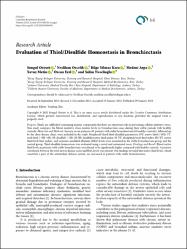Evaluation of thiol/disulfide homeostasis in bronchiectasis

Göster/
Erişim
info:eu-repo/semantics/openAccessTarih
2022Yazar
Özyurt, SongülÖzçelik, Neslihan
Kara, Bilge Yılmaz
Arpa, Medeni
Metin, Yavuz
Erel, Özcan
Neşelioğlu, Salim
Üst veri
Tüm öğe kaydını gösterKünye
Ozyurt, S., Ozcelik, N., Kara, B. Y., Arpa, M., Metin, Y., Erel, O., & Neselioglu, S. (2022). Evaluation of Thiol/Disulfide Homeostasis in Bronchiectasis. Canadian respiratory journal, 2022, 8340450. https://doi.org/10.1155/2022/8340450Özet
Purpose. Thiols are sulfhydryl-containing organic compounds that have an important role in preventing cellular oxidative stress. This study compares the blood oxidative stress marker levels in bronchiectasis cases during their stable periods with healthy controls. Materials and Methods. Seventy-seven patients (49 patients with stable bronchiectasis/28 healthy controls), followed up by the chest disease clinic, were included in the study. Peripheral blood thiol-disulfide parameters (NT: native thiol (-SH); TT: total thiol (-SH + SS); SS: disulfide (-SS); SS-SH: disulfide/native thiol index; SS-TT: disulphide/total thiol index; SH-TT: native thiol/total thiol index), and ischemia-modified albumin (IMA) levels were examined in the stable bronchiectasis group and the control group. Thiol-disulfide homeostasis was evaluated using a novel and automated assay. Findings and Result. Blood native thiol levels in patients with stable bronchiectasis were found to be significantly higher compared with healthy controls. A positive correlation between the total airway disease score and IMA levels was present. Our findings revealed that native thiol levels, which constitute a part of the antioxidant defense system, are increased in patients with stable bronchiectasis.

















